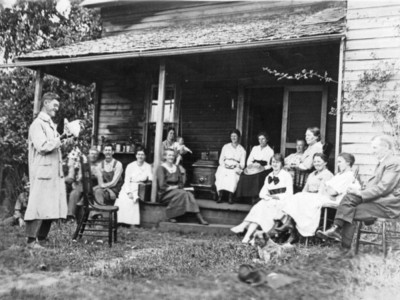The primary purpose of this demonstration is to carry directly to the farmer the latest information obtained through scientific investigation and practical observation of farm problems relating immediately to this local environment. This effort, however, is not actuated through a spirit of faultfinding with the present methods employed by the farmer, but with the single and sincere purpose of aiding, if possible, in the betterment of his financial and social position.
—James Withycombe, October 1911: “The Hog and Field Pea Special”
One of the key secrets to the success of Extension programs is their hands-on approach to education. Whether by train, car, or from a booth at the local fair or farmer’s market, Extension demonstrations engage all of the senses in learning. Agents faced a challenge in their approach to education. Unlike their colleagues who taught traditional courses at the college, Extension agents had to be particularly creative in the ways they conveyed their information. Because their audiences were voluntary and there were no mandatory classes to attend or formal assessments, these off campus educators had to be dynamic, entertaining, and most importantly, effective. The cornerstone of the “Extension method” was demonstration. The guiding principal behind demonstration techniques was that seeing is believing. Whether through field demonstrations in which one farmer would test a method and then share his results with his neighbors during a field meeting or through agent led presentations on everything from silo construction, cattle vaccination, insecticide use, or fruit tree pruning, the hope was that by actually performing the method and showing the results, agents would be able to effectively impart their knowledge.
At the time of Extension’s establishment in 1911, rail lines were just beginning to connect the state of Oregon. Trains opened new regions of the state to the market and attracted many new residents to try their hand in agriculture, particularly in Central Oregon where the rail line into Bend had just recently begun operation. To the faculty at Oregon Agricultural College, however, the trains did not just bring crops to the market; they also had the potential to bring the college to the state. At train stations in rural communities up and down the railways, local marching bands played music to entertain gathering crowds as they waited for the demonstration trains to arrive. Loaded with the latest in farm and home technology these exhibits on rails toured the state educating interested citizens in everything from animal husbandry and crop cultivation to fruit and vegetable canning. Guest lectures by OAC faculty used live animals, interactive displays, and the latest developments in electrical machinery to demonstrate the most modern of farm practices.



